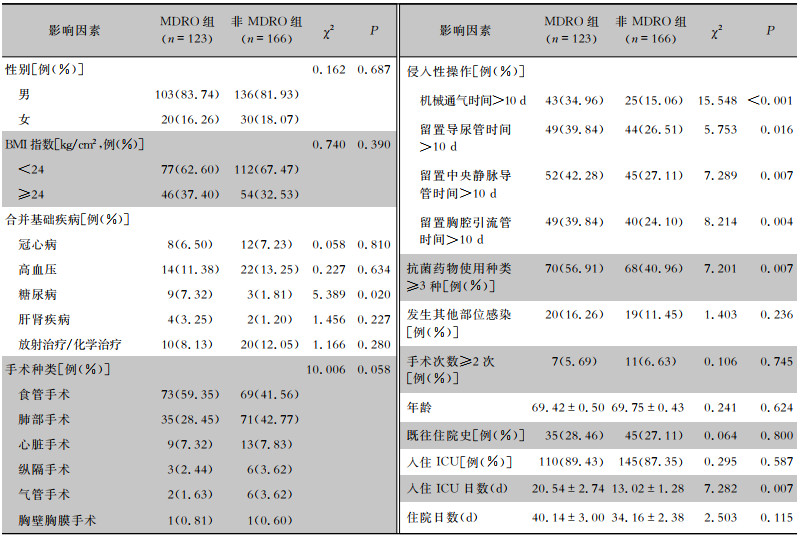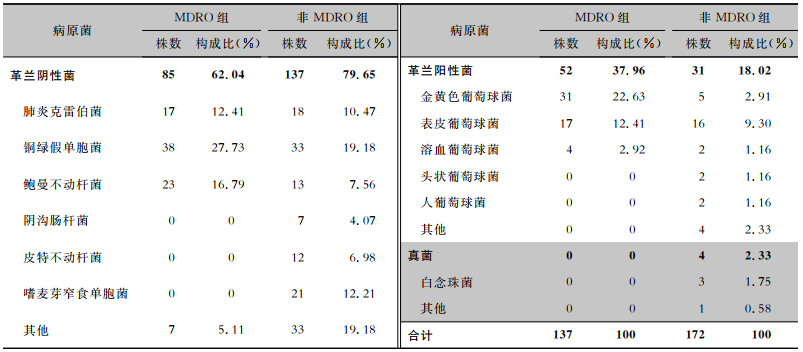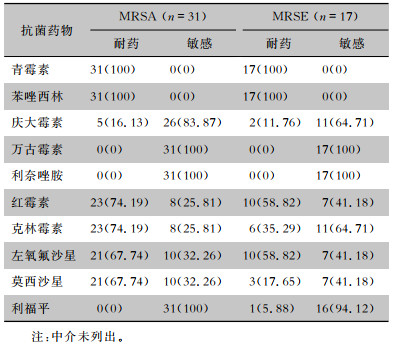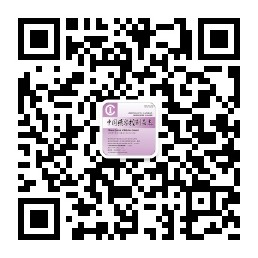2. 上海交通大学医院发展研究院医疗服务管理研究所,上海 200030
2. Institute of Hospital Service Management, Hospital Development Institute, Shanghai Jiao Tong University, Shanghai 200030, China
术后肺炎是外科手术后患者最常见的医院感染[1],往往导致患者长期生存率降低,医疗成本上涨[2]。美国一项研究[3]发现,不同外科手术患者术后肺炎发病率不同,心胸外科患者术后肺炎的发病率明显高于其他外科亚专科。同时多项研究[4-5]证实年龄是术后肺部感染的独立危险因素,主要与老年患者肺通气功能下降、肺组织弹性减退、免疫功能低下等有关。近年来多重耐药菌(multidrug-resistant organism, MDRO)检出率呈快速上升趋势,具有复杂性、反复性的特点,术后发生肺部MDRO感染常常影响患者预后,也是造成患者病情恶化甚至死亡的重要因素。本研究回顾性调查2020年1月—2022年12月老年患者心胸外科术后肺部感染病原菌的分布情况,MDRO检出及其耐药情况,并探讨术后肺部MDRO感染的危险因素,为此类感染的预防控制提供参考依据。
1 对象与方法 1.1 研究对象将2020年1月—2022年12月在上海市胸科医院进行心胸外科手术,且术后发生肺部感染的老年患者作为研究对象。根据术后肺部感染病原菌是否为MDRO,将纳入的研究对象分为MDRO组和非MDRO组。纳入标准:(1)年龄≥60岁;(2)在术后30 d内新发肺部感染;(3)临床资料完整。排除标准:(1)入院前已出现肺部感染或入院时已处于潜伏期的患者;(2)外院手术治疗后转诊至该院治疗的患者;(3)术前已进行气管插管或机械通气的患者。本研究经该医院伦理委员会审核同意。
1.2 研究方法 1.2.1 细菌鉴定与药敏试验采集患者痰标本进行病原学培养,采用Vitek 2 Compact全自动微生物鉴定系统(法国生物梅里埃公司)及其配套产品进行菌株鉴定和药敏试验,质控菌株为大肠埃希菌ATCC 25922、铜绿假单胞菌ATCC 27853、金黄色葡萄球菌ATCC 25923。药敏结果参照2018年美国临床实验室标准化协会(CLSI)标准[6]进行判断。对于同一患者痰标本检出的相同菌株,仅分析首次检出的菌株。
1.2.2 资料收集采用回顾性调查研究方法,通过医院信息系统查阅研究对象的电子病历,收集相关临床资料,包括年龄、性别、身高、体重、基础疾病、侵入性操作、抗菌药物使用情况、病原学资料、手术次数、手术种类、既往住院情况、ICU住院日数、总住院日数等。
1.2.3 诊断标准肺部感染诊断需符合《中国成人医院获得性肺炎与呼吸机相关性肺炎诊断和治疗指南(2018版)》[7]中的相关诊断标准;MDRO感染的诊断标准根据《多重耐药菌医院感染预防与控制技术指南(实行)》[8]执行。
1.3 统计分析应用SPSS 23.0统计软件对数据进行分析,患者的一般资料采用描述性统计,计数资料以数字或百分比表示,采用χ2检验或Fisher确切概率法进行比较;正态计量资料采用x±s表示,组间比较采用t检验。将单因素分析差异有统计学意义的研究指标,采用logistics回归分析模型进行多因素分析。P≤0.05为差异有统计学意义。
2 结果 2.1 基本情况2020年1月—2022年12月共有23 905例老年患者进行心胸外科手术,术后发生肺部感染289例,感染发病率为1.21%。术后肺部感染发病率前三位的手术依次为食管手术(6.67%)、气管手术(3.56%)、心脏手术(2.46%)。见表 1。289例术后肺部感染患者,123例痰标本分离出MDRO,纳入MDRO组,166例痰标本未分离出MDRO,纳入非MDRO组。
| 表 1 心胸外科不同手术种类的老年患者术后肺部感染情况 Table 1 Postoperative PI in elderly patients who underwent different types of cardiothoracic surgery |

|
老年患者心胸外科手术后肺部MDRO感染单因素分析显示,糖尿病、机械通气时间>10 d、留置中央静脉导管时间>10 d、留置导尿管时间>10 d、留置胸腔引流管时间>10 d、抗菌药物使用种类≥3种的比例,MDRO组高于非MDRO组(均P<0.05);入住ICU日数MDRO组长于非MDRO组(P<0.05)。见表 2。
| 表 2 心胸外科老年患者术后肺部MDRO感染的单因素分析 Table 2 Univariate analysis on postoperative MDRO PI in elderly patients who underwent cardiothoracic surgery |

|
多因素logistic回归分析发现,糖尿病(P=0.012)、机械通气时间>10 d(P=0.008)、抗菌药物使用种类≥3种(P=0.032)是心胸外科老年患者术后肺部MDRO感染的独立危险因素。见表 3。
| 表 3 心胸外科老年患者术后肺部MDRO感染logistic回归分析 Table 3 Logistic regression analysis on postoperative MDRO PI in elderly patients who underwent cardiothoracic surgery |

|
MDRO组123例患者的痰标本共分离病原菌137株,居前三位的依次为铜绿假单胞菌(27.73%)、金黄色葡萄球菌(22.63%)、鲍曼不动杆菌(16.79%)。非MDRO组166例患者的痰标本共分离病原菌172株,居前三位的依次为铜绿假单胞菌(19.18%)、嗜麦芽窄食单胞菌(12.21%)、肺炎克雷伯菌(10.47%)。见表 4。
| 表 4 心胸外科老年患者术后肺部感染病原菌分布 Table 4 Distribution of pathogens in postoperative PI in elderly patients who underwent cardiothoracic surgery |

|
17株耐碳青酶烯类肺炎克雷伯菌(carbapenem-resistant Klebsiella pneumoniae, CRKP)对头孢他啶、氨曲南、头孢吡肟、哌拉西林/他唑巴坦的耐药率>94%;23株耐碳青霉烯类鲍曼不动杆菌(carbapenem-resistant Acinetobacter baumannii, CRAB)对头孢他啶、亚胺培南、美罗培南的耐药率达100%;38株耐碳青霉烯类铜绿假单胞菌(carbapenem-resistant Pseudomonas aeruginosa, CRPA)对亚胺培南、左氧氟沙星、环丙沙星、美罗培南的耐药率均>68%。见表 5。
| 表 5 主要多重耐药革兰阴性菌对抗菌药物的耐药情况[株(%)] Table 5 Antimicrobial resistance of major multidrug-resistant Gram-negative bacteria (No. of isolate [%]) |

|
31株耐甲氧西林金黄色葡萄球菌(methicillin-resistant Staphylococcus aureus, MRSA)对克林霉素、红霉素的耐药率均>74%,未检出对万古霉素、利奈唑胺、利福平耐药的菌株。17株耐甲氧西林表皮葡萄球菌(methicillin-resistant Staphylococcus epidermidis, MRSE)对红霉素、左氧氟沙星的耐药率均为58.82%。见表 6。
| 表 6 主要多重耐药革兰阳性菌对抗菌药物的耐药情况[株(%)] Table 6 Antimicrobial resistance of major multidrug-resis-tant Gram-positive bacteria (No. of isolate [%]) |

|
近年来,国内已有多项针对老年肺部MDRO感染危险因素的研究,但由于研究对象存在选择偏倚,导致结论各不相同。一项针对375例80岁以上老年患者的研究[9]发现,留置胃管及深静脉导管、低白蛋白血症、ICU住院史、联合使用抗菌药物是高龄患者MDRO感染的独立危险因素。谢朝云等[10]针对老年慢性肺源性心脏病患者肺部MDRO感染的研究结果显示,6个月内住院史、使用糖皮质激素、联合使用抗菌药物≥3种是MDRO感染的独立危险因素。
本研究中研究对象均为≥60岁的心胸外科术后患者,结果显示患有糖尿病是术后肺部MDRO感染的独立危险因素。由于糖尿病患者血液中的高糖环境有利于细菌的侵入与定植[11],同时糖尿病会导致中性粒细胞功能障碍,无法正常有效地清除病原体[12]。当患者进行外科手术后,机体免疫力明显下降,致使肺部MDRO感染的易感性增加。本研究发现抗菌药物使用种类≥3种也是老年患者术后肺部MDRO感染的独立危险因素。庞天义等[13]针对274例老年肺部感染住院患者的研究发现,抗菌药物使用种类≥2种及抗菌药物使用时间≥2周会导致老年患者发生MDRO感染。池水晶等[14]研究发现,抗菌药物使用时间≥14 d及抗菌药物种类≥3种是术后MDRO肺部感染的独立危险因素。这是因为在大量联合使用广谱抗菌药物的作用下,可能形成多种耐药机制,如产生钝化酶、改变细菌外膜通透性及靶位蛋白等,从而最终导致多重耐药、广泛耐药,甚至泛耐药细菌的出现[15]。机械通气作为有创操作,损伤了患者的气道黏膜屏障,导致痰液淤积于呼吸道无法正常排出,引起细菌不断繁殖,增加肺部感染的风险[16]。同时患者持续机械通气往往需要长期使用抗菌药物,这也可能导致MDRO的产生。
多重耐药革兰阴性杆菌的出现往往与临床不良结局密切相关,已成为全世界范围内严重的公共卫生问题[17]。本研究检出的MDRO以革兰阴性菌为主,其中以铜绿假单胞菌居多,与赵建兰等[18]的研究结果一致。铜绿假单胞菌作为医院获得性感染的条件致病菌,是老年肺部感染的常见病原菌[19]。但也有研究[20-21]发现,肺部MDRO感染患者中鲍曼不动杆菌占比最高,说明研究对象纳入的条件、样本量及研究地区的差异均会造成MDRO检出结果的不一致。
药敏试验结果显示,心胸外科老年患者术后肺部感染的MDRO对常用抗菌药物均具有较强的耐药性。周俊立等[22]研究发现,肺部感染患者多重耐药铜绿假单胞菌对头孢菌素类、单环内酰胺类、青霉素类的耐药率均>70%。本研究中铜绿假单胞菌对左氧氟沙星、亚胺培南、环丙沙星等耐药率较高。此外,本研究发现CRKP对头孢菌素类、β-内酰胺酶抑制剂、氨基糖苷类抗生素的耐药率均高,与肖晓等[23]研究结果相似。汪加朋等[20]研究肺部MDRO感染发现,MRSA对利奈唑胺、万古霉素等较敏感,与研究结果一致。万古霉素是目前治疗肺部MRSA感染的首选药物,但要警惕在老年患者使用中引发肾损伤的可能性[24]。
本研究仍存在一定局限性。首先,作为单中心回顾性研究,数据来源于同一医院的心胸外科老年手术患者资料,存在一定的选择偏倚;其次,由于部分临床医生对电子病历书写重视度低、临床资料不完整等原因,术后肺部感染的诊断可能存在遗漏的情况;最后,本研究时间跨度较短,样本量较少,研究结果势必存在一定局限性。因此,期待以后可开展多中心、前瞻性、大样本的研究,进一步验证本研究结果的准确性。
综上所述,心胸外科老年患者术后发生肺部MDRO感染主要以铜绿假单胞菌、金黄色葡萄球菌为主,对常用抗菌药物均具有较高的耐药率。糖尿病、抗菌药物使用数量、机械通气时间是术后肺部MDRO感染的独立危险因素。
利益冲突:所有作者均声明不存在利益冲突。
| [1] |
中华预防医学会医院感染控制分会第四届委员会重点部位感染防控学组. 术后肺炎预防和控制专家共识[J]. 中华临床感染病杂志, 2018, 11(1): 11-19. Key Site Infection Prevention and Control Group of the Fourth Committee of Hospital Infection Control Branch, Chinese Preventive Medicine Association. Expert consensus on prevention and control of postoperative pneumonia[J]. Chinese Journal of Clinical Infectious Diseases, 2018, 11(1): 11-19. DOI:10.3760/cma.j.issn.1674-2397.2018.01.003 |
| [2] |
Walder B, Story DA. Postoperative pneumonia: can this important complication be predicted and anticipated?[J]. Eur J Anaesthesiol, 2019, 36(2): 87-89. DOI:10.1097/EJA.0000000000000922 |
| [3] |
Chughtai M, Gwam CU, Khlopas A, et al. The incidence of postoperative pneumonia in various surgical subspecialties: a dual database analysis[J]. Surg Technol Int, 2017, 30: 45-51. |
| [4] |
Xiang BB, Jiao SL, Si YY, et al. Risk factors for postoperative pneumonia: a case-control study[J]. Front Public Health, 2022, 10: 913897. DOI:10.3389/fpubh.2022.913897 |
| [5] |
Lee YH, Kim DH, Kim J, et al. Risk assessment of postopera-tive pneumonia in cancer patients using a common data model[J]. Cancers (Basel), 2022, 14(23): 5988. DOI:10.3390/cancers14235988 |
| [6] |
CLSI. Performance standards for antimicrobial susceptibility testing: M100 28th edition[S]. Berwyn: CLSI, 2018.
|
| [7] |
中华医学会呼吸病学分会感染学组. 中国成人医院获得性肺炎与呼吸机相关性肺炎诊断和治疗指南(2018年版)[J]. 中华结核和呼吸杂志, 2018, 41(4): 255-280. Infection Group, Respiratory Branch, Chinese Medical Associa-tion. Guidelines for the diagnosis and treatment of Chinese adult hospital acquired pneumonia and ventilator associated pneumonia(2018 edition)[J]. Chinese Journal of Tuberculosis and Respiratory Diseases, 2018, 41(4): 255-280. |
| [8] |
中华人民共和国卫生部. 多重耐药菌医院感染预防与控制技术指南(试行)[J]. 中国危重病急救医学, 2011, 23(2): 65. Ministry of Health, PRC. Technical guidelines for the prevention and control of hospital infection caused by multidrug resistant bacteria (trial)[J]. Chinese Critical Care Emergency Medicine, 2011, 23(2): 65. |
| [9] |
李茜, 王丽竹, 朱祎容, 等. 高龄老年肺部感染患者多药耐药菌分布及危险因素[J]. 中华医院感染学杂志, 2022, 32(14): 2104-2107. Li Q, Wang LZ, Zhu YR, et al. Multidrug-resistant organi-sms isolated from elderly patients with pulmonary infection and risk factors[J]. Chinese Journal of Nosocomiology, 2022, 32(14): 2104-2107. |
| [10] |
谢朝云, 李耀福, 蒙桂鸾, 等. 老年慢性肺源性心脏病合并肺部多重耐药菌感染相关因素分析[J]. 解放军医药杂志, 2020, 32(1): 56-59. Xie CY, Li YF, Meng GL, et al. Related factors of pulmonary multidrug-resistant bacterial infection in elderly patients with chronic pulmonary heart disease[J]. Medical & Pharmaceutical Journal of Chinese People's Liberation Army, 2020, 32(1): 56-59. |
| [11] |
黄鸿, 黄芪, 徐海, 等. 老年糖尿病并发肺部感染病原学及影响因素[J]. 中华医院感染学杂志, 2021, 31(8): 1179-1182. Huang H, Huang Q, Xu H, et al. Etiology and influencing factors of pulmonary infection in the elderly with diabetes mellitus[J]. Chinese Journal of Nosocomiology, 2021, 31(8): 1179-1182. |
| [12] |
Frydrych LM, Bian GW, O'Lone DE, et al. Obesity and type 2 diabetes mellitus drive immune dysfunction, infection deve-lopment, and sepsis mortality[J]. J Leukoc Biol, 2018, 104(3): 525-534. |
| [13] |
庞天义, 满德强, 常群. 老年肺部感染住院患者合并多重耐药菌感染的危险因素探讨及风险Nomogram模型的建立[J]. 中国抗生素杂志, 2021, 46(12): 1157-1160. Pang TY, Man DQ, Chang Q. Study on the risk factors of multidrug-resistant bacteria infection and the establishment of risk nomogram model in elderly patients with pulmonary infection[J]. Chinese Journal of Antibiotics, 2021, 46(12): 1157-1160. |
| [14] |
池水晶, 封燚, 李慧, 等. 多重耐药菌感染术后肺炎相关危险因素分析及控制方法学探究[J]. 中华全科医学, 2021, 19(4): 671-673, 701. Chi SJ, Feng Y, Li H, et al. Analysis of risk factors related to pneumonia after multidrug-resistant bacterial infection and exploration of control methodology[J]. Chinese Journal of General Practice, 2021, 19(4): 671-673, 701. |
| [15] |
Martin-Loeches I, Rodriguez AH, Torres A. New guidelines for hospital-acquired pneumonia/ventilator-associated pneumonia: USA vs. Europe[J]. Curr Opin Crit Care, 2018, 24(5): 347-352. |
| [16] |
刘晓倩, 陶赟臻, 赵晓秋, 等. 河北省某院老年患者肺部感染流行病学特征及风险预测模型的构建[J]. 公共卫生与预防医学, 2022, 33(3): 127-129. Liu XQ, Tao YZ, Zhao XQ, et al. Epidemiological characteri-stics and risk prediction model of pulmonary infection in elderly patients in a hospital in Hebei Province[J]. Journal of Public Health and Preventive Medicine, 2022, 33(3): 127-129. |
| [17] |
Otsuka Y. Potent antibiotics active against multidrug-resistant Gram-negative bacteria[J]. Chem Pharm Bull (Tokyo), 2020, 68(3): 182-190. |
| [18] |
赵建兰, 许东风, 赵静, 等. 老年肺部感染住院患者多药耐药菌感染影响因素的回顾性调查[J]. 中华医院感染学杂志, 2019, 29(6): 835-838. Zhao JL, Xu DF, Zhao J, et al. Retrospective survey of influencing factors for multidrug-resistant organisms infections in elderly hospitalized patients with pulmonary infections[J]. Chinese Journal of Nosocomiology, 2019, 29(6): 835-838. |
| [19] |
冯磊, 丛燕, 顾翔宇, 等. 老年患者肺部铜绿假单胞菌感染临床特征及多重耐药株感染危险因素分析[J]. 老年医学与保健, 2019, 25(2): 169-173. Feng L, Cong Y, Gu XY, et al. Clinical characteristics of pulmonary pa infection and risk factors of MDR-pa infection in the elderly[J]. Geriatrics & Health Care, 2019, 25(2): 169-173. |
| [20] |
汪加朋, 徐化强, 汪文国. 肺部感染患者多重耐药菌的耐药性分析[J]. 中国卫生标准管理, 2019, 10(3): 44-46. Wang JP, Xu HQ, Wang WG. Drug resistance of multidrug-resistant bacteria in patients with pulmonary infection[J]. China Health Standard Management, 2019, 10(3): 44-46. |
| [21] |
曹桂花, 葛伟, 薛明涛. 高龄肺部感染患者多重耐药菌的分布及临床特点[J]. 中华老年多器官疾病杂志, 2018, 17(10): 753-756. Cao GH, Ge W, Xue MT. Distribution and clinical characte-ristics of multidrug-resistant bacteria in the elderly patients with pulmonary infection[J]. Chinese Journal of Multiple Organ Diseases in the Elderly, 2018, 17(10): 753-756. |
| [22] |
周俊立, 张文萃, 王莹莹, 等. 肺部感染患者多重耐药铜绿假单胞菌的耐药谱与特征[J]. 中华疾病控制杂志, 2020, 24(9): 1046-1050, 1062. Zhou JL, Zhang WC, Wang YY, et al. Drug resistance spectrum and characteristics of multi-drug resistant Pseudomonas aeruginosa in patients with pulmonary infection[J]. Chinese Journal of Disease Control & Prevention, 2020, 24(9): 1046-1050, 1062. |
| [23] |
肖晓, 杭修兵, 王梦, 等. 耐碳青霉烯类肠杆菌目细菌耐药性、临床感染特征及mcr基因分析[J]. 中国感染控制杂志, 2023, 22(1): 31-37. Xiao X, Hang XB, Wang M, et al. Antimicrobial resistance, clinical infection characteristics and mcr genes of carbapenem-resistant Enterobacterales[J]. Chinese Journal of Infection Control, 2023, 22(1): 31-37. |
| [24] |
徐勤, 曹季平, 周佳琦. 万古霉素对耐甲氧西林金黄色葡萄球菌肺部感染的临床应用[J]. 中华保健医学杂志, 2020, 22(6): 607-609. Xu Q, Cao JP, Zhou JQ. Observation of vancomycin supplement dose, blood concentration and renal function in patients with pulmonary infection of MRSA[J]. Chinese Journal of Health Care and Medicine, 2020, 22(6): 607-609. |




 唑
唑